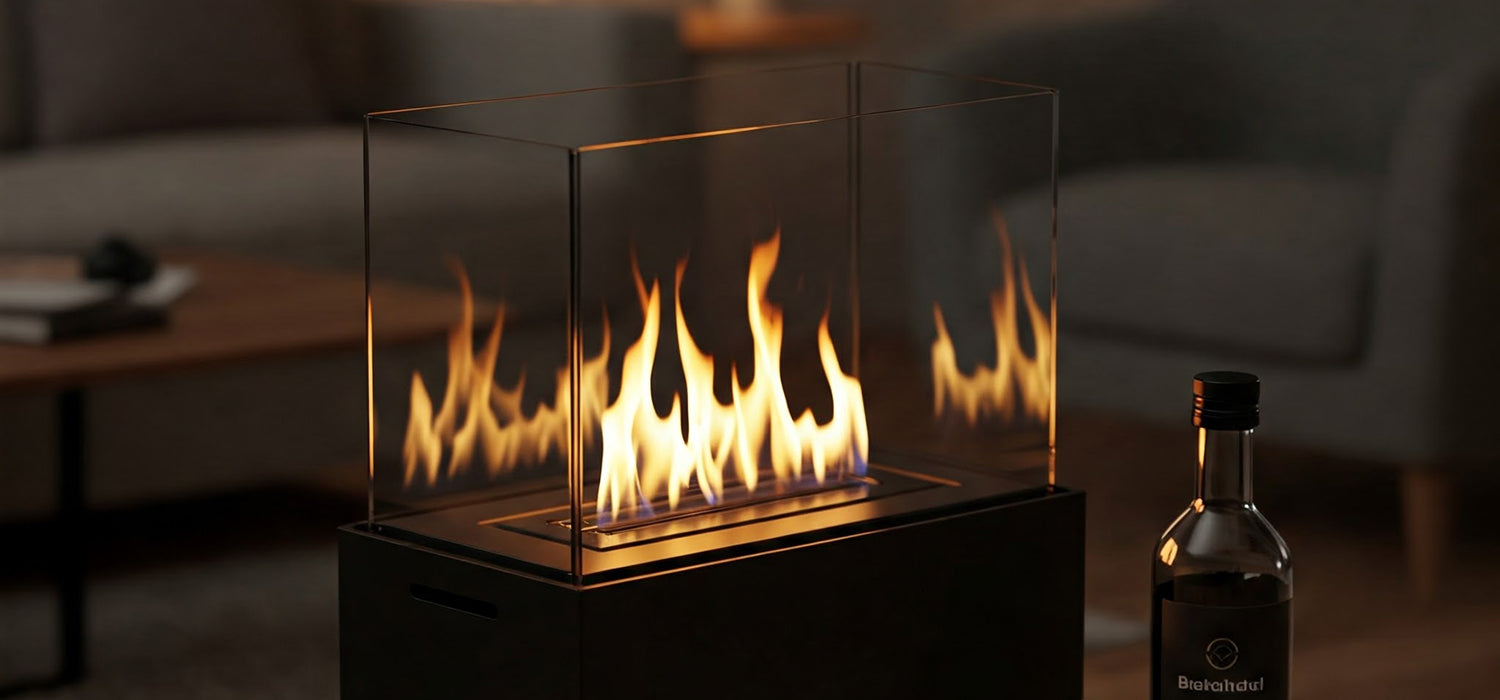
How Long Will 1 Litre of Bioethanol Last? A Practical Guide for Home & Garden Use
Ever settled in by your Bioethanol Fire and thought, “How long till this thing runs dry?” Short answer: 1 litre lasts around 2 to 5 hours. But burn time isn’t one-size-fits-all—flame height, burner style, and even room drafts matter. Stick around for clever ways to make it last longer.
Understanding Bioethanol Burn Time
The Average Lifespan of 1 Litre of Bioethanol
The big question on everyone’s mind: how long does a single litre of bioethanol actually last?
In most cases, you’ll get anywhere from 2 to 5 hours of burn time, depending on how you’re using it. But just like a car uses more petrol when you floor the accelerator, bioethanol burns faster when you crank up the flame.
Let’s take a closer look at what different burner sizes can deliver.
Typical Burn Times for Different Burner Sizes
Small Burners (0.5 - 1 Litre Capacity):
Expect around 2–4 hours of burn time. These are often found in tabletop models—perfect for dinner parties or a cosy evening glow.
Medium Burners (1.5 - 2 Litre Capacity):
These offer 4–6 hours of gentle heat and ambiance. Ideal for a standard indoor fireplace.
Large Burners (2+ Litre Capacity):
With the flame turned down a bit, you could see 6–8+ hours of steady heat—great for long events or overnight patio warmth.
What Affects the Average Burn Time?
A few things can make that litre stretch further—or disappear faster:
-
Burner Size and Capacity: Larger burners hold more fuel, but may also release heat faster depending on the flame setting.
-
Flame Height and Intensity: The higher the flame, the quicker your fuel disappears. Keep it lower for a longer-lasting glow.
-
Ventilation and Airflow: Too much airflow can speed up combustion. Draughty rooms = shorter burn time.
-
Bioethanol Quality and Purity: Premium fuels burn cleaner and slower. Cheaper blends can vanish in a flash.
-
Room Temperature: Colder rooms sometimes extend burn time slightly, while warmer ones may accelerate it.
Key Factors Influencing Bioethanol Consumption
The Type and Size of Your Bioethanol Fireplace
Not all bioethanol fireplaces are created equal. The size and style of your unit have a huge impact on fuel use.
Tabletop vs. Freestanding vs. Wall-Mounted Units
-
Tabletop Units: These use smaller burners and are designed for ambiance rather than heat. Lower consumption but shorter flames.
-
Freestanding Fireplaces: Medium burners with moderate fuel use—great for zone heating in lounges or conservatories.
-
Wall-Mounted Units: Often decorative, they balance appearance with modest heat output and fuel usage.
Burner Design and Fuel Box Capacity
High-efficiency burners like those from EcoSmart or Planika are built to maximise every drop of bioethanol. Poorer designs may leak heat or use fuel unevenly.
Larger fuel boxes can be convenient, but they also tempt you to run the flame higher and longer—resulting in more frequent top-ups.
Adjusting Flame Settings for Efficiency
High vs. Low Flame and Fuel Usage
It’s simple really—a high flame burns fuel faster. It might look lovely, but if you’re aiming for efficiency, turn it down a notch.
Finding the Balance Between Ambiance and Economy
A good rule of thumb? Start low. If the room still feels chilly, turn it up just slightly. You’ll be surprised how a soft, steady flame can both warm the space and stretch your fuel further.
The Impact of Bioethanol Fuel Quality
Purity Levels and Their Effect on Burn Rate
Premium bioethanol fuels (usually 95–97% pure) are cleaner, safer, and longer-lasting. They leave less residue, which means your burner stays efficient over time.
The Role of Additives and Their Potential Drawbacks
Some fuels include additives to reduce odour or boost flame colour. But beware—these can increase fuel consumption or leave behind unwanted residue.
Stick with certified, high-quality bioethanol wherever possible.
Environmental Conditions and Their Influence
How Ventilation Affects Fuel Consumption
It’s all about airflow. In well-ventilated spaces, oxygen feeds the flame, increasing combustion speed. That means shorter burn times.
The Impact of Drafts and Open Windows
Got a window open nearby? A light draught might feel nice but it can slash your burn time by up to 30%. Use wind guards for outdoor setups and keep indoor spaces calm for a more controlled burn.
Maximising the Burn Time of Your Bioethanol
Choosing the Right Bioethanol Fuel
Opting for High-Quality, Pure Bioethanol
This one’s easy: better fuel = better results. Look for bioethanol that’s certified, odourless, and high in purity.
Considering Low-Odour Options
If you’re using it indoors, you’ll appreciate low-odour fuel. It makes the space more pleasant, especially during long burns.
Efficient Fireplace Usage Practices
Starting with a Lower Flame Setting
Think of it like dimming a light—you still get the glow, but with less power. Starting low can add an extra hour or more to each litre.
Avoiding Overfilling the Burner
Tempting as it is to fill to the brim, overfilling can cause spillage and inconsistent burn performance. Stick to the max fill line.
Proper Bioethanol Fuel Storage
Ideal Storage Conditions (Cool, Dry, Away from Heat)
Keep your fuel in a cool, dry cupboard or garage—somewhere away from direct sunlight or heat sources.
The Importance of Using Certified Containers
Only use properly sealed, certified fuel containers. This protects both the fuel quality and your safety.
Shelf Life Considerations
Most high-quality bioethanol has a shelf life of 2–3 years. Check expiry dates and rotate older bottles first.
Bioethanol Consumption Rates and Costs
Typical Bioethanol Consumption per Hour
Ranges from 0.2 to 0.7 Litres per Hour
Depending on flame size and burner design, you’ll typically burn 0.2 to 0.7 litres per hour. Lower flames in smaller units can push closer to the lower end.
Examples Based on Different Fireplace Types
-
Tabletop Burner: 0.2–0.3 L/hr
-
Wall-Mounted Fireplace: 0.3–0.5 L/hr
-
Freestanding Heater: 0.5–0.7 L/hr
Calculating the Running Costs of a Bioethanol Fire
Factoring in Fuel Price and Burn Time
UK fuel prices range from £2.50–£4 per litre. So, if your burner uses 0.5L per hour, you’re looking at around £1.25–£2 per hour to run.
Comparing Costs to Other Heating Options
Electric heaters may cost more per hour, especially if left on overnight. Bioethanol has no installation costs, no electricity draw, and zero maintenance. If you’re heating occasionally or just want the ambience, it can be a budget-friendly winner.
Conclusion: Getting the Most Out of Your 1 Litre of Bioethanol
Bioethanol might not replace your boiler, but for stylish heat and atmosphere? It’s a game-changer.
A single litre can last anywhere from 2 to 8 hours, depending on how you use it. Burner size, flame height, room conditions, and fuel quality all play a role.
Whether it’s for romantic evenings, garden gatherings, or a touch of class in your lounge, bioethanol offers clean, simple warmth—with zero smoke and minimal fuss. Take a little care with your setup, choose your fuel wisely, and you’ll be getting the best bang for your (bio) buck.
Ready to fuel your fire the smart way?

